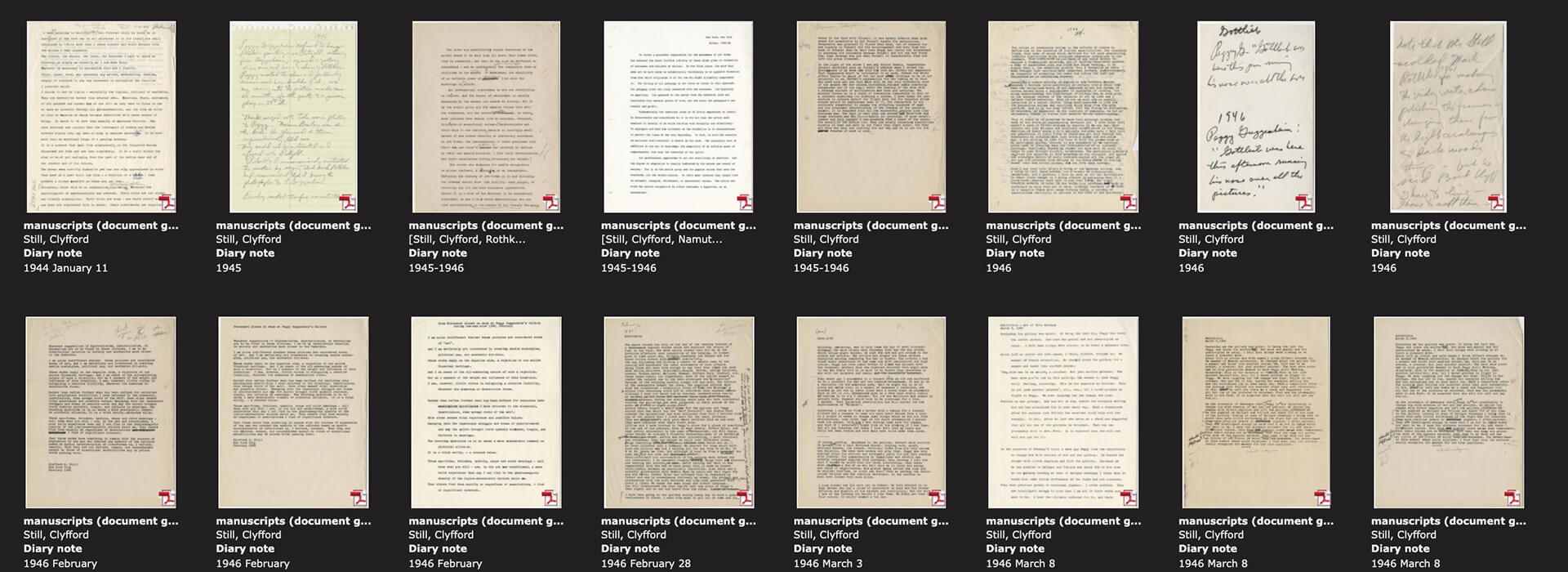Denver, CO – March 22, 2021 – The Clyfford Still Museum (CSM) digitally released the first segment of Clyfford Still’s diary notes to the public through the Museum’s online research catalog, Luna earlier this month.
The processing of the diary notes included the surveying, arranging, describing, preserving, scanning, digital processing, creation of metadata, and uploading of the notes of all 484 diary notes by Rachel Hancock, CSM associate archivist and Milo Carpenter, CSM associate digital archivist.
The first segment of materials consists of 105 pieces of writing and correspondence by Still from 1944-1951 and focuses on his time painting while living in San Francisco and his changing opinions about the New York art scene in the 1950s. The notes also touch on Still’s relationships with other abstract expressionist painters, including Jackson Pollock, Mark Rothko, and Robert Motherwell. Additionally, the notes contain details about Still’s relationship with his family.
The Museum will release additional segments of Still’s diary notes in the coming months.
Highlights Chosen by CSM Archivists
When someone titled a painting of Still’s that had been reproduced in Tiger’s Eye “The Grail,” he railed against that decision with this note on why he does not title his paintings. “The paintings I show lack titles for the reasons as profound as their implications to myself, and the relation I would establish between them and others with comparable sensibilities,” said Still. “To impose any literary allusion is to establish a serious block to communication; to title this particular picture ‘The Grail’ without noting that I was not the author of the title, borders on a presumptuous insult.”
In this letter to Rothko, Still discusses some of his approach to painting and the evolution of his work towards greater abstraction. In a letter to Patricia, Still describes a night when he went out drinking with Pollock and includes some of Pollock’s plans to leave the major galleries, a move Still would eventually take as well.
Still described his changing opinions about galleries and museums in New York in a letter to his first wife Lillian. “I have retired from the Betty Parsons gallery for reasons you can well guess,” said Still. “Our interests are so opposite on every plan that there is nothing but loss and mockery for me to remain in it. I don’t belong to the world she and the rest represent, nor do they understand mine. I am on my own again.”
He also described his love for baseball in a letter to his second wife Patricia where he discusses throwing a baseball around with Barney Newman and Ad Reinhardt.
About the Clyfford Still Museum
Designed by Allied Works Architecture to display the revolutionary art of one of the 20th century’s greatest artists, the Clyfford Still Museum opened in November 2011 in Denver’s Golden Triangle Creative District. Considered one of the most important and mysterious painters of the 20th century, Clyfford Still (1904-1980) was among the first generation of abstract expressionist artists who developed a new and powerful approach to painting in the years during and immediately after World War II. The Museum’s collection represents more than 93% of the artist’s lifetime output. As the steward of Still’s art and legacy, the Museum’s mission is to preserve, exhibit, study, and foster engagement with its unique collections; generate outstanding exhibitions, scholarly research, educational and other cross-disciplinary programs that broaden the definition of a “single-artist” museum; and be a gathering place for the exploration of innovation and individual artistic endeavor. Connect with the Clyfford Still Museum on Facebook, Twitter, Instagram or at clyffordstillmuseum.org.
# # #
